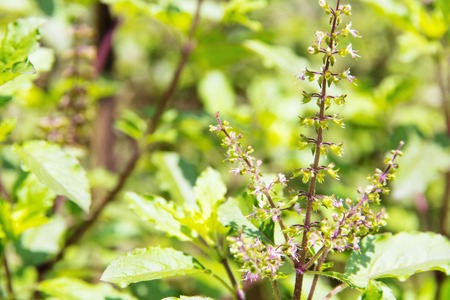Holy basil
 Ocimum tenuiflorum, commonly known as tulasi (from Sanskrit), tulsi, or holy basil, is an aromatic perennial plant in the family Lamiaceae.[2][3] It is widely cultivated throughout the Southeast Asian tropics.[1][4][5] It is native to tropical and subtropical regions of Asia, Australia and the western Pacific.[1] This plant has escaped from cultivation and has naturalized in many tropical regions of the Americas.[3][6] It is an agricultural and environmental weed.[3]
Ocimum tenuiflorum, commonly known as tulasi (from Sanskrit), tulsi, or holy basil, is an aromatic perennial plant in the family Lamiaceae.[2][3] It is widely cultivated throughout the Southeast Asian tropics.[1][4][5] It is native to tropical and subtropical regions of Asia, Australia and the western Pacific.[1] This plant has escaped from cultivation and has naturalized in many tropical regions of the Americas.[3][6] It is an agricultural and environmental weed.[3]
Tulasi is cultivated for religious and traditional medicine purposes, and also for its essential oil. It is widely used as an herbal tea, commonly used in Ayurveda. It has a place within the Vaishnava tradition of Hinduism, in which devotees perform worship involving the plant or its leaves.
Holy basil is an erect, many-branched subshrub, 30–60 cm (12–24 in) tall with hairy stems. Leaves are green or purple; they are simple, petioled, with an ovate blade up to 5 cm (2 in) long, which usually has a slightly toothed margin; they are strongly scented and have a decussate phyllotaxy. The purplish flowers are placed in close whorls on elongated racemes.[7]
The three main morphotypes cultivated in India and Nepal are Ram tulsi (the most common type, with broad bright green leaves that are slightly sweet), the less common purplish green-leaved (Krishna or Shyam tulsi) and the common wild vana tulsi (e.g., Ocimum gratissimum).[8]
The plant and its oil contain diverse phytochemicals, including tannins, flavonoids, eugenol, caryophyllenes, carvacrol, linalool, camphor, and cinnamyl acetate, among others.[9][10] One study reported that the plant contains an eponymous family of 10 neolignan compounds called tulsinol A-J.[11]
Specific aroma compounds in the essential oil are camphor (32%), eucalyptol (19%), ⍺-bisabolene (17%), eugenol (14%), germacrene (11%) and β-bisabolene (11%).[12][better source needed] In addition, more than 60 different aroma compounds were found through gas chromatography–mass spectrometry analysis of holy basil.[12] However, other studies have stated tulsi essential oil consists mostly of eugenol (70%) β-elemene (11%), β-caryophyllene (8%), and germacrene (2%), with the balance being made up of various trace compounds, mostly terpenes.[13]
The leaves of holy basil, known as kaphrao in the Thai language (กะเพรา), are commonly used in Thai cuisine for certain stir-fries and curries such as phat kaphrao (ผัดกะเพรา) — a stir-fry of Thai holy basil with meats, seafood or, as in khao phat kraphao, with rice. Two different types of holy basil are used in Thailand, a "red" variant which tends to be more pungent, and a "white" version for seafood dishes.[14][15] Kaphrao should not be confused with horapha (โหระพา), which is normally known as Thai basil,[16] or with Thai lemon basil (maenglak; แมงลัก).
Holy basil (in Minangkabau language and Indonesian language are known as ruku-ruku (id)) is also widely used for Minangkabau dishes, particularly for its gulai variety, which involves fish as the primary source of protein.[17] These Minangkabau fish gulais that commonly use holy basil such as gulai ikan mas (carp gulai), gulai ikan kakap (red snapper gulai), gulai kepala ikan kakap (red snapper's head gulai), samba ikan gadang or pangek (braised fish gulai),[18] and gulai telur ikan (fish roe gulai). Holy basil leaves are used to enhance flavour.
For centuries, the dried leaves have been mixed with stored grains to repel insects.[19]
The essential oil may have nematicidal properties against Tylenchulus semipenetrans, Meloidogyne javanica, Anguina tritici, and Heterodera cajani.[20]
Tulasi has been used in Ayurvedic and Siddha practices for its supposed medicinal properties.[21][22]
Tulasi is a sacred plant for Hindus, particularly the Vaishnavite sect. It is worshipped as the avatar of Lakshmi,[citation needed] and is often planted in courtyards of Hindu houses or temples to Hanuman.[23] The ritual lighting of lamps each evening during Kartik includes the worship of the tulsi plant.[24][25] Vaishnavites are also known as "those who bear the tulsi around the neck".[23]
Tulasi Vivaha is a ceremonial festival performed between Prabodhini Ekadashi (the 11th or 12th lunar day of the bright fortnight of the Hindu month of Kartika) and Kartik Purnima (the full moon of the month).[26][27]
Every evening, Odia and Bengali Hindus place earthen lamps in front of tulsi plants. During the Kati Bihu festival celebrated in Assam, people light earthen lamps (diya) at the foot of the household tulsi plants and pray.[28]